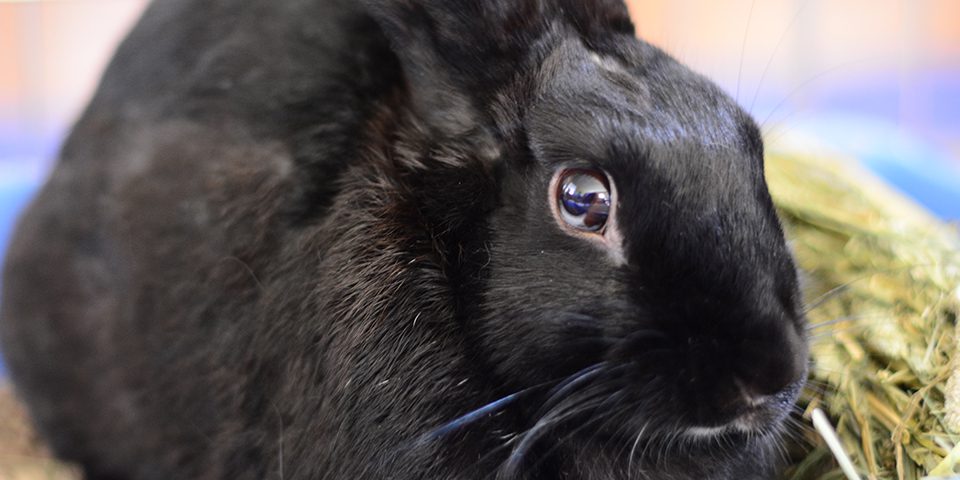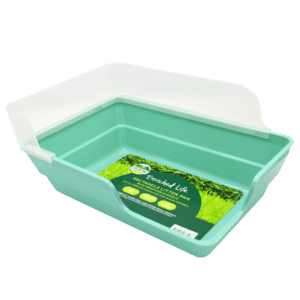By Kellie Hayden
Updated: March 3, 2024
As many bunny parents know, rabbits are naturally very clean animals. Other than habitat maintenance, brushing, nail clipping, and the occasional spot cleaning, bunnies rarely need human intervention when it comes to hygiene.
Like many other small animal species, rabbits are also creatures of habit when it comes to elimination. This makes rabbits perfect candidates for litter training.
Even though rabbits are quick learners, litter training your bunny might still seem like a daunting task. Luckily, Oxbow is here to help!
Below, we’ll show you how to litter train your rabbit, including the supplies you’ll need and step-by-step instructions to follow. We’ve also included a handy set of tips and tricks, along with frequently asked questions about rabbit potty training.
Rabbit Litter Training Supply List
Rabbit Litter
When potty training your bunny, the right type of litter is important. As many pet parents know, rabbit urine tends to have a strong odor. Finding a way to combat odor while tackling absorbency can be tricky.
Rabbits are known for chewing on their litter. Make sure whatever product you use is fit for small animal species and will not cause digestive or respiratory issues for your pet.
We recommend avoiding clay litters that contain crystals, such as litters found in the cat aisle of your local pet store. These crystals are not formulated for rabbits and may be toxic to your pet. We also recommend against using cedar shavings or chips, as the oils in the wood can cause respiratory issues, skin irritation, and possibly liver damage in rabbits.
What about newspaper or recycled paper? While it can be used as a lining for litter pans, paper as a substrate absorbs urine odors and will quickly start to smell. A good litter will control odors instead of absorbing them.
So what’s the best type of litter for rabbits?
We recommend either using a wheat straw rabbit litter, such as Oxbow’s Eco-Straw, or using your rabbit’s favorite hay as a substrate.
Eco-Straw is clumpable, scoopable, environmentally friendly, and is safe if consumed in small amounts. Use at least one inch of Eco-Straw in the bottom of your pet’s litter box.
Many pet parents and veterinary professionals also agree that Western Timothy Hay is an ideal substrate. Other hays can include Orchard Grass or Hay Blends. If you decide to use hay as a litter, always offer a separate hay source for your rabbit to consume. While rabbits like to poop where they eat, they always need a clean, unlimited source of hay. We recommend trying out Prime Cut Hay Hearty and Crunchy and Soft and Lush to see which hay cutting your pet prefers.
Litter Box
Cat litter boxes can be a great place to start when it comes to litter pan selection. Make sure to get a litter box that’s large enough for your rabbit to turn around, stretch out, and relax. Rabbits tend to spend a lot of time in their litter boxes, and they need to be as comfortable as possible.
The litter box ideally should have easy-to-clean corners and few to no crevices where residues can build up over time and hide from the cleaning process. Stick with solid bottoms to litter boxes and avoid mesh or grated material.
As far as potty training goes, rabbits are similar to cats in that each rabbit will need their own litter box. If there are more than 3 rabbits in your home, plan on purchasing one more litter box than the number of rabbits you have. This means if you have 4 rabbits, you will want 5 litter boxes.
Litter Scoop
A necessary part of having a litter box is also having a litter scoop. While cat litter scoops may be an option available at the pet store, the scoop can also be a food scoop if you are short on options (just make sure it continues to be the poop scoop afterwards!). Similar to the litter box, the litter scoop should be easy to clean with few hiding places for dirt and grime.
Training Rewards
Finally, your pet will need to connect the use of their new litter box with a reward. To do this you will need one of their favorite snacks, even if that snack is a handful of hay. While the reward can be anything from one of Oxbow’s species-appropriate treats to your rabbit’s favorite veggies or greens, make sure that you follow daily serving guidelines and don’t give your pet too many treats.
Litter Training: A Step-by-Step Guide
Once you have your supplies gathered, now comes the work: actually training your little one to use the litter box. Below, we’ll show you how to litter train your rabbit in four steps:
1. Set Up Litter Boxes for Training
2. Discourage Eliminating Outside the Litter Boxes
3. Reward Your Rabbit for Using the Litter Boxes
4. Continue Training to Form a Routine
Step 1: Set Up Litter Boxes for Training
When introducing a litter pan to your bunny’s enclosure, make sure that there is still plenty of room for their water source, food, and toys.
When setting up litter boxes around your house, litter boxes should be placed in areas where your rabbit already typically goes to the bathroom, such as particular corners where you might have found urine spots. If you place a litter box in a corner, it might be helpful to cover the walls nearby to protect the area. Litter pans with high walls or covered litter boxes help a great deal with wall and floor protection.
During the training process and beyond, make sure to avoid changing the location of litter boxes if your rabbits are using them with any regularity. These kinds of changes need to be gradual, moving the pan only a foot or so a week, or your rabbits may no longer use the moved litter box and opt to eliminate where the litter box once was.
Step 2: Discourage Eliminating Outside the Litter Boxes
After you add the litter pan to your rabbit’s favorite area of their habitat, keep an eye on your pet. Spend time daily watching and interacting with them, and watch for signs of urinating and defecating.
If your rabbit “gets into position” outside of the litter box, simply first say “No,” and gently herd or place them in the litter box. As with any interaction with your pet, never shake, yell at, or become physically aggressive with your rabbit.
Much like other animals when it comes to house training, rabbits need immediate correction. If rabbits aren’t caught in the act of eliminating, they shouldn’t be reprimanded for it later. Instead, keep a close eye on them for the next time they appear to be eliminating so the behavior can be corrected then.
Step 3: Reward Your Rabbit for Using the Litter Boxes
When you observe your pet do the desired behavior (using the litter pan), allow them to finish and immediately offer them both a reward and praise! Depending on your pet’s personality, the ideal praise may be verbal, or may be physical in the form of ear or forehead scritches.
Step 4: Continue Training to Form a Routine
Repetition is the name of the game with any kind of behavioral training. Make sure to continue monitoring your pet, correcting them as needed, and rewarding them for the desired behavior of using their litter box. As you plan to go through this training process, make sure you are not about to go out of town or on vacation for more than a day or two! During the training period your pet’s brain will be working on connecting their litter box behavior to a good outcome (a treat) or a null outcome (no treat), and too much disruption to this new routine may ruin any progress that is made.
If you have others in the house to who care for your rabbit, make sure they are on board with this new routine and understand how to properly correct and reward your bunny for litter box usage. The more repetition the better, and the message your rabbit receives needs to the be same from every family member who regularly has a role in caring for your bunny.
Rabbits may take their time to learn but are ultimately creatures of habit. Once they begin to understand what it is that they’re “supposed” to do and develop a routine, they are likely to stick with it.
When it comes to adjusting bunny behavior, patience is key. While your pet is never too young or too old to try litter training, it may take time for them to adjust to your expectations of where it is and isn’t appropriate to eliminate waste.
Continue rewarding their desired behavior of litter box usage until your rabbit consistently uses the litter box on their own.

Tips for House Training Your Rabbit
- Once your rabbit has established where the litter box is located, avoid moving it unless absolutely necessary. However, if you find that they’re repeatedly using one specific area where the litter box isn’t located, you can move a litter box that is never used to their preferred area. Another option is to leave the litter box where it is and add another litter box to the area they prefer.
- Rabbits will sometimes kick their litter out of the box. If this becomes an issue, we recommend purchasing a hooded or covered litter box.
- During the litter training process, we recommend leaving your bunny be when they are in the litter box. Much like their human counterparts, invading their space and territory in the midst of “using the facilities” is frowned upon and may result in behavioral issues. This includes waiting to scoop their litter pan until they are not using it.
- One of the most difficult parts of rabbit potty training is being able to identify a true training fail vs. marking their territory. Rabbits may leave “pills” outside of their litter boxes to send out the alert to fellow bunny friends that this territory is theirs. This also helps them identify what territory isn’t theirs (think of your favorite rug or the sofa).
- Accidents happen, and there are many pet-friendly products on the market to clean stains and odor from carpet and other surfaces.
- Adding a handful of hay to their facilities is a great way to encourage your pet to spend time in the litter box.
Tips for Rabbit Litter Box Cleaning
- We recommend spot cleaning your rabbit’s litter box daily, and then emptying and replacing the litter once per week.
- We recommend washing litter pans once per month.
- White vinegar works well for rinsing litter boxes. You can also clean litter boxes with soap and hot water. Whatever you use, always finish cleaning litter pans with a final rinse of water.
- Ensure that the pan is completely dry before refilling it with litter. Use a cloth or paper towel to dry the pan.
- Some litters, especially the organic varieties like our Eco-Straw, can be composted either through commercial composting or through your own personal compost pile. If you decide to compost litter at home, make sure that your compost pile adequately reaches the right temperatures needed to kill harmful microbes and germs.

Frequently Asked Questions
When Should I Litter Train My Rabbit?
Generally, the sooner you can litter train your rabbit the better. If you are bringing home a rabbit who will be unfamiliar with your home, allow them time to adjust to their new surroundings. However, you also do not want to wait too long to attempt litter training and risk undesirable behaviors developing. Undesirable behaviors can be difficult to curb and may even require additional training outside of the litter training process. Once your rabbit has adjusted to home life with you, and once you will be home enough to monitor your pet during the initial training phases, you can begin.
How Long Does It Take to Litter Train a Rabbit?
Simply put, every bunny is different! Training a rabbit is not always easy. Some rabbits may catch on faster than others. While there is no “one size fits all answer” here, your consistency with redirection and positive reinforcement will be key to helping your rabbit understand the desired behavior at a faster pace.
Does Spaying or Neutering Rabbits Help with Litter Training?
While not a guarantee, it is thought that spaying or neutering your rabbit can make them more receptive to litter box training. In general, spaying or neutering can help curb territory marking (or “spraying”), and will make your rabbit less likely to urinate on people or other animals. The sooner you can alter your rabbit the better, as it’s recommended to spay or neuter rabbits when they’re approximately 3-6 months old.
What If My Rabbit Keeps Eliminating Outside the Litter Box?
If your rabbit continues to eliminate outside of the litter box in spite of your best efforts it may leave you feeling frustrated, but underlying issues could be at hand. For example, if the litter box entrance has a high lip that your older rabbit must jump over to access the box, using the litter box may be difficult or painful for them due to joint problems such as arthritis. If your litter training attempts have been unsuccessful, it’s worth making an appointment with your exotics vet to discuss what barriers your rabbit may be encountering (literally or figuratively) when using the litter box.



